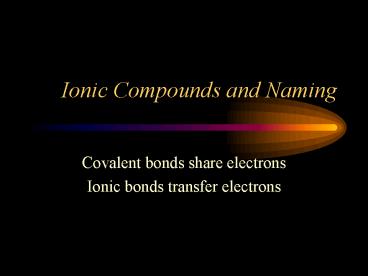Ionic Compounds and Naming - PowerPoint PPT Presentation
Title:
Ionic Compounds and Naming
Description:
Title: Chemical Names, Symbols and Formulas. Author: Stanley John Doddridge Last modified by: cwatson Created Date: 11/25/2001 12:54:03 AM Document presentation format – PowerPoint PPT presentation
Number of Views:70
Avg rating:3.0/5.0
Title: Ionic Compounds and Naming
1
Ionic Compounds and Naming
- Covalent bonds share electrons
- Ionic bonds transfer electrons
2
Ionic Bonds
- Ionic compounds - made when two ions join.
- Are due to an electrostatic attraction between
ions of opposite charge. - Cations are positively charged ions (metals).
- Anions are negatively charged ions (non-metals).
3
Chemical Names, Symbols and Formulas.
- We must have a uniform way to represent all
chemicals.
.
4
Names are often based on a property or a
discoverer.
- Sodium - Arabic word suda means headache.
- Hafnium - discovered in Copenhagen. (Latin
Hafnia) - Lithium - Gk lithos means rock or stone
- Curium - for Marie Curie.
5
Symbols used in place of the name.
- O
- N
- C
- H
- Oxygen
- Nitrogen
- Carbon
- Hydrogen
6
First letter is always capitalized in a symbol -
other letters are always lower case
- Co
- CO
- Cobalt
- Carbon Monoxide
7
First letter is always capitalized in a symbol -
other letters are always lower case
- Sulfur
- Selenium
- Strontium
- Sodium
- S
- Se
- Sr
- Na
8
Formula - a combination of symbols showing
composition.
- Subscript - a small number that tells how many
atoms of the element are in the compound. - H2O means that two atoms of hydrogen are
chemically bonded to one atom of oxygen.
- Subscript is written after the element it
describes. - Why isnt there anything written after the O
for oxygen? - If there is no number, 1 is implied.
9
Formula - a combination of symbols showing
composition.
- Oxidation number of hydrogen is 1 ()
- Oxidation number of oxygen is 2- (--)
- s have to equal -s
- have two (-)s therefore need two ()s
O - -
H H
or
10
Formula - a combination of symbols showing
composition.
- Coefficient - large number written in front of
the formula.
6 H2O
- Coefficient tells how many formula units are
present.
6 H2O H2O H2O H2O H2O H2O H2O
or
11
Binary Compounds
- Two elements form a compound.
Al2S3
- First name the cation normally, followed by the
anion, changing the anions suffix to -ide.
Aluminum Sulfur
12
Binary Compounds
- Two elements form a compound.
Al2S3
- First name the cation normally, followed by the
anion, changing the anions suffix to -ide.
Aluminum Sulfur
ide
13
Examples
- CaBr2
- NaCl
- H2Se
- calcium bromide
- sodium chloride
- hydrogen selenide
14
Formula writing
- Write the correct chemical formula that would
form between - calcium and fluorine
- Rubidium and oxygen
- Magnesium and phosphorus
- Practice problems pg.217 s 7-11. Write correct
chemical formula and name
15
Part II - Naming Compounds
- Positive ion (cation) is always named and written
first!
16
Polyatomic Ion Compounds
Na2SO4
- Cation always goes first followed by anion.
- Do not change the polyatomic ions name in any
way.
!
sodium sulfate
- Na2SO4 sodium sulfate
- Na2S sodium sulfide
- What are the differences?
17
Polyatomic Ions
- If multiples of the same polyatomic ion are used,
then use parenthesis to show the multiples. - Ca 2OH- Ca(OH)2
18
Polyatomic Ions
- If multiples of the same polyatomic ion are used,
then use parenthesis to show the multiples. - Ca 2OH- Ca(OH)2
- Remember, OH- is a single polyatomic unit.
- If you dont use the parenthesis it would mean 2
hydrogens but only one oxygen instead of two
hydroxides.
19
Examples
- K2SO4
- Li3PO4
- BaCrO4
- potassium sulfate
- lithium phosphate
- barium chromate
- ammonium dichromate
- (NH4)2Cr2O7
20
Stock Naming System
- Used with transition elements and those other
which can have multiple oxidation numbers (Fe
2,3)? Pg. 222 - Iron oxide could be
- Fe2O3 or
- FeO
21
Stock Naming System
- To clarify this, the oxidation number is stated
immediately after the cation, then the anion is
named as usual with its -ide ending in the case
of binary compounds or the polyatomic name in the
case of polyatomic ions. - Because iron has an oxidation number of two in
the formula FeO, its name is iron two oxide. - But we use roman numerals to write it out. So. .
. . - FeO is iron(II) oxide.
- Remember the roman numeral refers to the
oxidation number NOT the subscript!
22
Stock Naming System
- Fe2O3 would therefore be . . .
- Iron (III) oxide.
- What is the formula for manganese (III) fluoride?
- MnF3
- What is the name of NiO2?
- Nickel (IV) oxide.
23
Part III
- Mercury is special!
24
Mercury
- Mercury II is written Hg2
- Mercury I is written Hg22
- Why?
- Hg Hg Hg22
25
Covalently Bonded Binary Molecules
- When naming things that bond covalently,
(nonmetal to nonmetal), where oxidation numbers
are not helpful we use a system which uses
prefixes. - Water, therefore could be called dihydrogen
monoxide. Di indicating there are two hydrogens
and mono indicating one oxygen. (Note the other
binary rules still apply giving oxygen the -ide
ending. - What is the formula for trinitrogen pentoxide?
- N3O5

